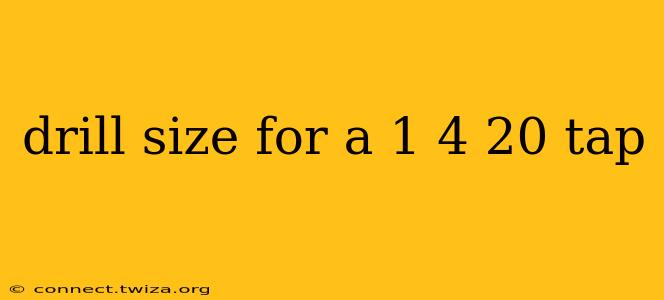Choosing the right drill bit size for tapping a 1/4-20 thread is crucial for ensuring a clean, accurate, and strong screw connection. A poorly sized hole can lead to stripped threads, a broken tap, or a weak joint. This guide will clarify the correct drill size and address common questions surrounding this process.
What is a 1/4-20 Tap?
Before diving into drill sizes, let's define what a 1/4-20 tap is. The "1/4" refers to the nominal diameter of the tapped hole (approximately 0.25 inches). The "20" indicates the number of threads per inch. This means there are 20 individual threads within one inch of the tapped hole's length.
What Size Drill Bit Should I Use for a 1/4-20 Tap?
The ideal drill bit size for a 1/4-20 tap is #7 (0.201 inches). This leaves sufficient material for the tap to cut clean threads without causing excessive stress or breakage. Using a smaller drill bit can lead to difficulty tapping and potential thread damage. Conversely, a larger drill bit will result in loose and potentially unusable threads.
It's important to remember that these measurements are approximate. Slight variations can occur depending on the specific tap and material being worked with. Always consult the tap manufacturer's specifications for the most accurate information.
What Happens If I Use the Wrong Drill Size?
Using an incorrectly sized drill bit can result in several problems:
-
Too Small: The tap might break, strip the threads in the hole, or create an unnecessarily tight fit, making it difficult to assemble.
-
Too Large: The resulting threads will be weak and prone to stripping. The screw may not hold securely, potentially leading to failure of the assembly.
What Kind of Drill Bit Should I Use?
While the size is critical, the type of drill bit also matters. For best results with tapping 1/4-20 threads, use a high-speed steel (HSS) drill bit. These bits are designed to withstand the stresses of drilling and are readily available at most hardware stores.
What Materials Are Commonly Tapped with a 1/4-20 Tap?
1/4-20 taps are frequently used across various materials, including:
-
Steel: A common material in various applications, from machinery parts to structural components.
-
Aluminum: Used in lighter applications where strength is still required.
-
Brass: Often used for decorative or less demanding applications.
How Do I Ensure Accurate Drilling?
Precise drilling is crucial for successful tapping. Here are some tips:
-
Use a drill press: A drill press provides greater control and consistency compared to a hand drill.
-
Use a vise: Securely clamp the workpiece in a vise to prevent movement during drilling.
-
Lubricate the drill bit: Lubrication reduces friction and heat, improving the drilling process and extending the life of the bit.
How Much Clearance Should I Leave for the Tap?
The #7 drill bit provides the necessary clearance for a 1/4-20 tap. The slight difference between the drill bit size and the tap's major diameter ensures proper thread formation without excessive force.
What are the Consequences of Using Too Much Cutting Fluid?
Excessive cutting fluid can sometimes hinder the tapping process. It can potentially wash away chips and debris preventing proper thread formation. While lubrication is essential, it's crucial to use the appropriate amount—not an excessive deluge.
By following these guidelines and selecting the correct drill bit, you can ensure a successful and robust threaded connection every time you use a 1/4-20 tap. Remember to always prioritize safety and work carefully when using power tools.
